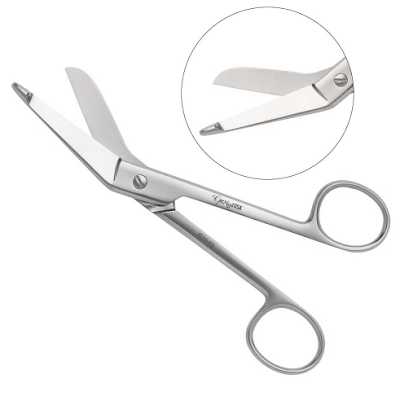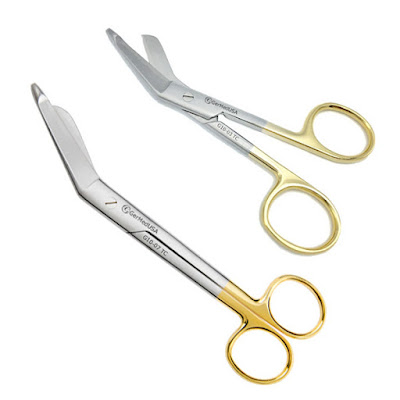In the highly controlled healthcare environment, where accuracy and productivity are paramount, quality surgical scissors are essential. These instruments are indispensable in innumerable treatments, from minor surgeries to life-threatening situations, yet more flashy pieces of equipment sometimes overlook them.
In this blog, you will learn about several kinds of surgical scissors, what they can do, and how their quality affects patient outcomes.
The Diverse Roles of Medical Scissors
Scissors are far from one-dimensional surgical instruments. They come in various designs and sizes, each meticulously crafted for specific purposes.
Here's a glimpse into the diverse roles they accomplish:
Surgical Scissors
These are the workhorses of the operating room. Typically crafted from high-grade stainless steel, surgical scissors feature sharp blades for precise tissue cutting, sutures, and dressings.
Their variations include:
- Mayo Scissors: Featuring straight blades with blunt tips for blunt dissection (separating tissues without cutting) and grasping.
- Metzenbaum Scissors: Characterized by angled blades with a fine tip for intricate dissection in tight spaces.
- Iris Scissors: Delicate and sharp-pointed, these surgical instruments are ideal for delicate eye surgeries.
Suture Scissors
Designed for meticulously removing sutures, these
medical scissors feature fine blades with a blunt tip to prevent accidental snagging or tearing of delicate tissues.
Bandage Scissors
Essential for first aid and wound care, these robust scissors are adept at cutting through bandages, clothing, and casts without harming the patient. They often feature a serrated edge for better gripping power.
Pediatric Scissors
Sized appropriately for smaller patients, pediatric scissors prioritize safety with blunt tips and a smaller cutting capacity.
This is just a sampling of the diverse medical scissor family. Each type caters to a specific need within the vast healthcare landscape.
Why Surgical Scissors Quality Matters?
While a pair of scissors might seem like a primary tool, its construction and design quality can significantly impact healthcare professionals and, ultimately, patient outcomes.
Here's how these surgical instruments quality improve practice outcomes:
1. Precision and Control
Blades that are sharp and well-crafted ensure clean cuts, reducing the amount of tissue damage and bleeding that occurs. This is necessary for sensitive treatments in which accuracy is paramount. Frayed edges, uncontrolled tissue manipulation, and increased healing time might result from using dull or improperly balanced scissors.
2. Time management and efficiency in operation
Time is a valuable commodity in extremely fast-paced healthcare settings. Cutting may be done quickly and effectively using quality scissors, which helps to ensure that processes are completed on time. It is especially vital to keep this in mind during times of crisis when every second matters.
3. Reduced Risk of Complications
Dull or damaged blades can snag or tear tissues, increasing the risk of infection and complications. High-quality scissors minimize this risk, promoting a smoother healing process.
4. User Comfort
Ergonomically designed handles with proper finger ring size minimize hand fatigue and discomfort for healthcare professionals during prolonged use. This improves user well-being and allows for greater control and precision.
5. Durability and Cost-Effectiveness
Buying quality medical scissors saves money over time. Superior materials and construction make the scissors durable for repeated sterilization and usage and reduce replacements, saving practices resources.
Choosing the Right Scissors:
With the vast array of surgical scissors available, selecting the right tool for the job becomes crucial.
Here are some factors to consider when opting for specific scissors:
Procedure
The type of procedure being performed dictates the scissor selection. Delicate eye surgery necessitates a pair of iris scissors, whereas removing a cast requires sturdy bandage scissors.
Tissue Type
Different tissues require varying cutting approaches. Blunt dissection of tough tissues might require
Mayo scissors, while finer dissection of delicate structures demands Metzenbaum scissors.
Blade Design
Straight blades offer versatility, while angled blades provide better access in tight spaces. Serrated edges enhance grip when cutting through bandages or clothing.
Material and Durability
Opt for medical-grade stainless steel for optimal sharpness, corrosion resistance, and ability to withstand sterilization.
Ergonomics
Consider the size, weight, and finger ring design for a comfortable grip and improved control, especially during extended procedures.
Consulting with experienced colleagues or surgical instrument specialists can also be invaluable in selecting the ideal scissors for specific needs.
The Future Advancement in Medical Scissors:
Manufacturers constantly innovate and develop designs and features to address evolving healthcare needs. Here's a glimpse into potential future trends:
Material Advancements
New materials with improved strength, corrosion resistance, and potentially self-sharpening properties could lead to longer-lasting and more precise instruments.
Minimally Invasive Procedures
As minimally invasive surgery (MIS) becomes more common, there will likely be a rise in demand for specialized scissors designed for these procedures. These would be smaller, more maneuverable, and compatible with robotic surgical systems.
Customization
Now, the customization of scissors is possible based on surgeon preferences or specific patient anatomy. This could include creating personalized handles or even blade configurations.
Conclusion
Quality medical scissors are essential to many healthcare procedures. Their diversified functions and huge influence on patient outcomes make them vital healthcare tools.
As technology advances and healthcare demands change, scissors will become more precise, efficient, and innovative, guaranteeing their critical position in patient care.
FAQs
Are all surgical scissors the same?
No, scissors come in various types, each designed for a specific procedure. For instance, Mayo scissors excel at blunt dissection, while Iris scissors are ideal for delicate eye surgeries. Materials and craftsmanship quality also impact factors like sharpness, precision, and user comfort.
What factors should I consider when choosing medical scissors?
The type of procedure, tissue being cut, and desired precision are all crucial. For instance, delicate tasks necessitate sharp, pointed scissors, while removing bandages requires a sturdier design. Material, ergonomics, and ease of sterilization are other vital considerations.



Post a Comment